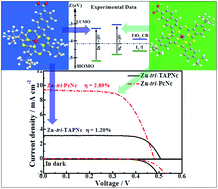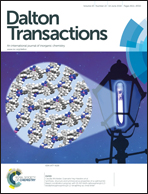Effects of benzo-annelation of asymmetric phthalocyanine on the photovoltaic performance of dye-sensitized solar cells†
Abstract
Novel highly asymmetric zinc tetraazaporphyrin (TAP) derivatives (Zn-tri-TAPNc and Zn-tri-PcNc) with one carboxyl and three tert-butyl peripheral substituent groups were synthesized. A highly asymmetric zinc phthalocyanine (ZnPc) derivative (Zn-tri-PcNc) has a benzo-annelated ring which contains tribenzonaphtho-condensed tetraazaporphyrin with the same peripheral substituents as Zn-tri-TAPNc. As a sensitizer for the TiO2-based dye-sensitized solar cell, Zn-tri-PcNc derived from the benzo-annelation of the TAP macrocycle showed improved light harvesting and electron injection efficiency, which can retard the charge recombination, resulting in a great improvement in the incident photon-to-current conversion efficiency (IPCE). The Zn-tri-PcNc-sensitized solar cell exhibited a higher conversion efficiency (2.89%) than the Zn-tri-TAPNc-sensitized one (1.20%) under AM 1.5G solar irradiation. The present results on the TAP macrocycle's benzo-annelation demonstrate that optimization of molecular structure via changing the peripheral substituent group's “push–pull” effect and enlarging the conjugated π-system is an effective approach to improve the performance of the tetraazaporphyrin-based dye-sensitized solar cell.


 Please wait while we load your content...
Please wait while we load your content...